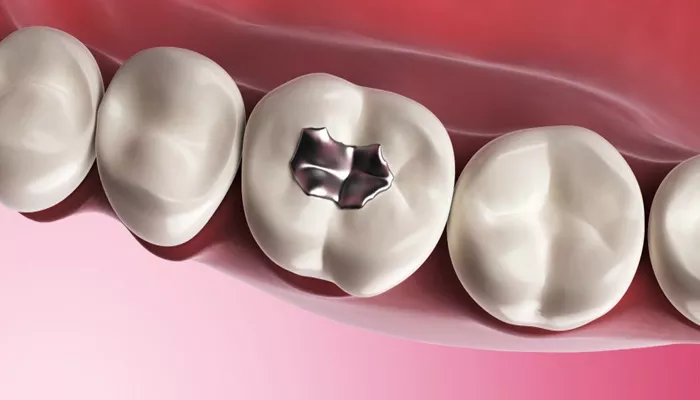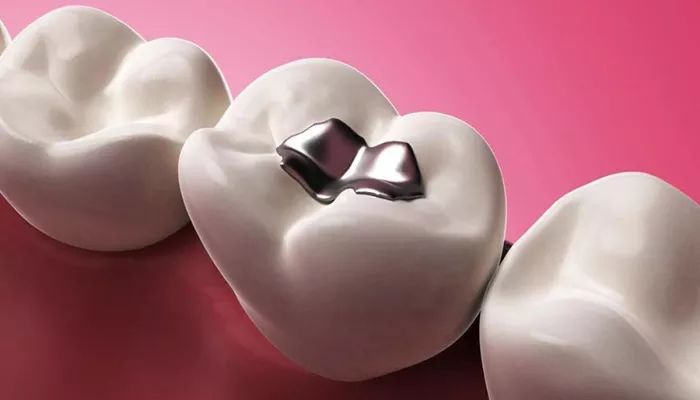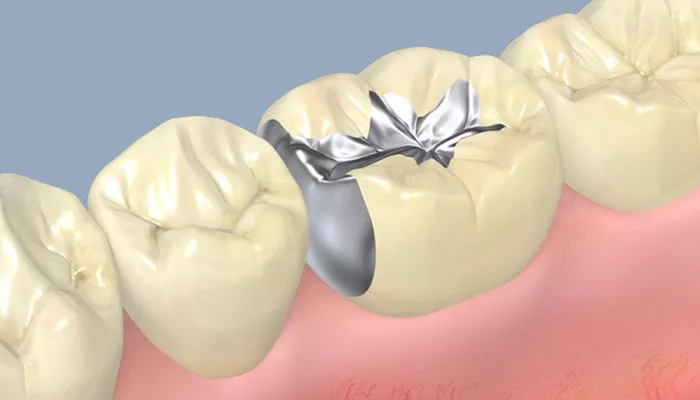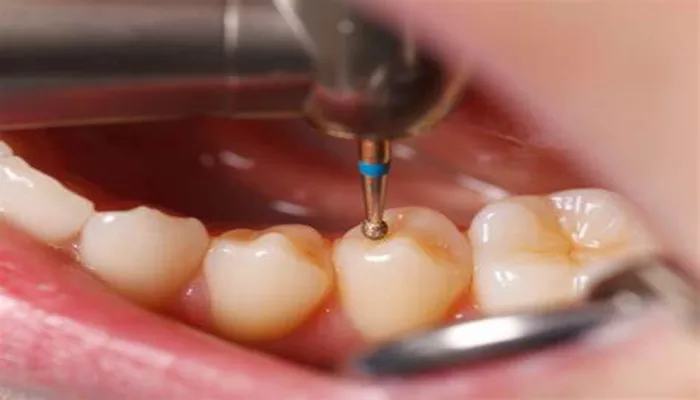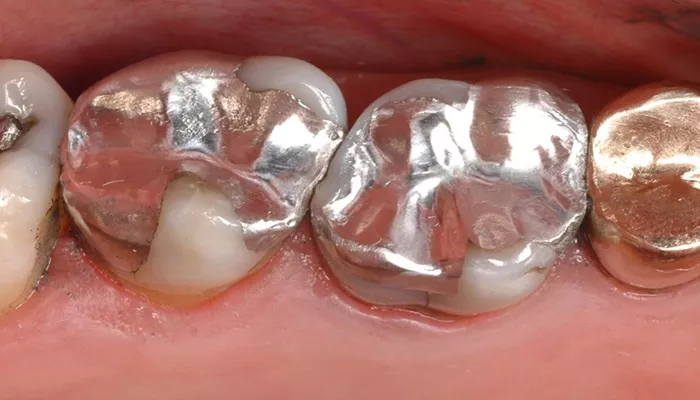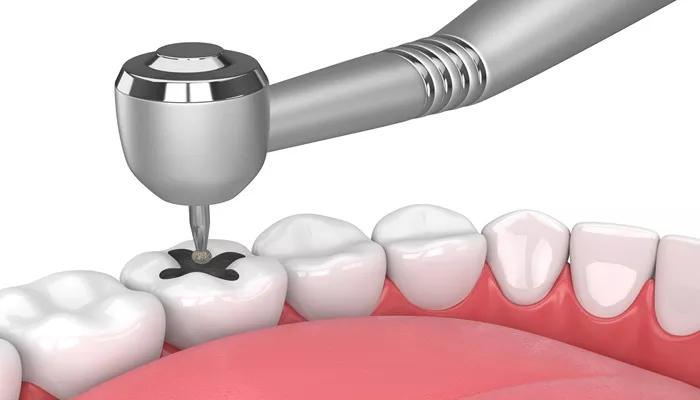Amalgam fillings are a durable, silver-colored dental material made from a mixture of metals, including silver, mercury, tin, and copper. Commonly used for back teeth, they are cost-effective, long-lasting, and resistant to wear, though they lack aesthetic appeal.
What is in an amalgam filling
1. Mercury (50%): The primary component of an amalgam filling is mercury, which binds the other metals together to form a stable material. Mercury is a liquid at room temperature, and when combined with the powdered metals, it hardens into a solid, durable filling. Although mercury is toxic in its pure form, it is considered safe in dental amalgam fillings due to its stable binding with the other metals.
2. Silver (22-32%): Silver is added to the amalgam mixture for its strength and durability. It gives the filling its characteristic silver-gray color and enhances the material’s resistance to corrosion.
3. Tin (14-30%): Tin helps with the malleability and workability of the amalgam, making it easier to place the filling into the cavity. Tin also contributes to the alloy’s ability to expand and contract without cracking when exposed to temperature changes in the mouth.
4. Copper (6-14%): Copper is added to the amalgam to increase its strength and wear resistance. It also reduces the risk of corrosion, making the filling longer-lasting.
5. Other Elements: Small amounts of zinc, palladium, or other metals may also be included to further enhance the material’s properties.
pros and cons of amalgam fillings
Pros of Amalgam Fillings
Amalgam fillings have been a popular choice for decades due to their many advantages. While they may not be as aesthetically pleasing as composite (tooth-colored) fillings, they offer significant benefits in terms of strength, durability, and cost-effectiveness.
1. Durability and Longevity
Amalgam fillings are known for their impressive durability. When properly placed, they can last for 10-15 years or even longer. This makes them an ideal choice for teeth that experience heavy biting forces, such as molars. The material is resistant to wear and tear, which is a key factor in its long lifespan.
2. Strength and Resistance to Fracture
Amalgam fillings are incredibly strong and are able to withstand the significant pressure from chewing. Unlike some other filling materials, amalgam does not easily crack or break under pressure. This makes them a great option for restoring the back teeth, which endure the most stress during chewing.
3. Cost-Effective
One of the main reasons why amalgam fillings remain popular is their cost-effectiveness. Compared to other filling materials such as gold or porcelain, amalgam is relatively inexpensive, making it a more affordable option for patients, especially when multiple fillings are needed.
4. Minimal Shrinkage
Amalgam fillings have minimal shrinkage after placement, meaning that they will not contract or shrink significantly as they harden. This helps ensure a tight seal around the filling and reduces the likelihood of secondary decay developing around the filling edges.
5. Ease of Placement
Amalgam fillings are relatively easy to place compared to more modern filling materials like composite resins. The material does not require specialized equipment or techniques, making it a fast and efficient choice for dental professionals.
6. Biocompatibility
Although amalgam contains mercury, the mercury is tightly bound to the other metals in the filling, making it chemically stable and safe for most patients. Over 100 years of research and clinical studies have shown that dental amalgam does not pose a significant risk to health when properly placed.
7. Resistance to Moisture
Amalgam is one of the best materials for use in areas of the mouth that are difficult to keep dry during treatment. Unlike composite materials that require a dry field for optimal placement, amalgam can be placed successfully even in areas where moisture control is challenging.Cons of Amalgam Fillings
While amalgam fillings offer a wide range of benefits, they are not without their drawbacks. As with any dental material, there are certain limitations and concerns associated with amalgam fillings that should be considered before making a decision.
1. Aesthetic Concerns
The most significant drawback of amalgam fillings is their appearance. The silver-gray color is conspicuous and can stand out against the natural color of teeth. This makes amalgam fillings less desirable for fillings in visible areas, such as the front teeth, where appearance is a primary concern. For this reason, composite or porcelain fillings are typically preferred for front teeth.
2. Mercury Content
The inclusion of mercury in amalgam fillings is one of the most controversial aspects of this material. While the mercury is chemically bound to the other metals in the filling and does not pose a significant health risk when the filling is intact, there are ongoing concerns about mercury exposure, particularly if the filling cracks, leaks, or is removed improperly. Some patients, especially those with a history of mercury sensitivity or those who are pregnant, may choose to avoid amalgam fillings for this reason.
3. Potential for Expansion and Contraction
Although amalgam fillings generally experience minimal shrinkage after placement, they do expand and contract slightly in response to temperature changes in the mouth. This expansion and contraction can sometimes cause the filling to loosen or cause minor cracks in the surrounding tooth structure over time. This is particularly a concern with larger fillings that are subjected to significant temperature changes.
4. Destruction of Healthy Tooth Structure
In order to place an amalgam filling, the dentist must remove a significant amount of healthy tooth structure to ensure a good fit. While amalgam is durable, the preparation process may weaken the tooth, making it more prone to fractures. Composite fillings, in contrast, typically require less removal of tooth tissue, which helps preserve more of the tooth’s natural structure.
5. Longer Setting Time
Compared to other modern filling materials like composites, amalgam fillings take longer to set and harden. This means that the patient may need to avoid chewing or applying pressure on the filled tooth for several hours after the procedure, depending on the size of the filling.
6. Environmental Concerns
Dental offices that use amalgam are required to dispose of the material responsibly due to concerns over the mercury content. While dental amalgam has a long track record of safety when properly handled, there is ongoing debate about its environmental impact, particularly when dental waste is not disposed of correctly.
7. Allergic Reactions
Though rare, some patients may have an allergic reaction to one of the metals in amalgam, such as silver or copper. If this occurs, the dentist may recommend an alternative filling material, such as composite resin or porcelain.

